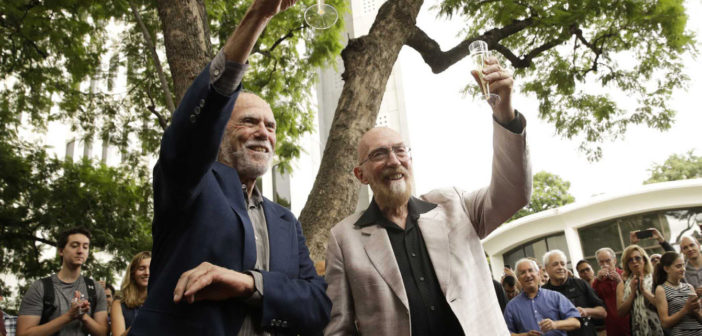[tribulant_slideshow gallery_id=”177″]
By: Victoria Cavillo
On Oct. 3, three American scientists won the Nobel Prize for proving Albert Einstein’s theory of relativity correct. Rainer Weiss, Barry Barish, and Kip Thorne were all part of a team of about 1,000 people who first witnessed the gravitational waves, which were first theorized by Einstein in 1916.
One of the reasons why this theory has taken decades to investigate is because it is very complicated to many people, even Saint Leo University’s Assistant Professor of Theology, Dr. Michael Novak.
“It makes perfect sense up to a point, where I don’t understand any of it. It makes sense in lining up with what I have personally observed with the universe and have observed along with astronomers,” said Novak. “It’s the same way with things that don’t make sense on the surface, such as if I take a steel rod and I stick it into a pool of water it bends. So, it’s like, wow water bends steel? Then when I take it out, it’s straight again, you know it’s just refracting light. It’s more complicated than what appears on the surface, but it makes sense once you understand what is going on. Likewise, we have observed the way that mass can distort light and space.”
Online magazine, Wired, wrote that Weiss and Thorne started their exploration for gravitational waves in the 1970’s. The pair built prototypes of lasers that they thought could measure the smallest change in length.
Wired also mentioned that Weiss was mostly in charge of the engineering parts of the laser, while Thorne dealt with the theoretical calculations. The design they developed detected, “compressions in spacetime thousands of times smaller than the width of a proton,” stated Wired.
The online magazine stated that Barish was also credited due to his expertise in assembling and managing the team that found the discovery called Laser Interferometer Gravitational Wave Observatory, otherwise known as LIGO. He was made the leader of the team in 1994, and he recruited members from all over the world to help work on the observations.
Fox News reported, “The waves are detected by a laser device, called an interferometer, which must be both exquisitely precise and extremely stable in a project that cost $1.1 billion dollars.” They also mentioned that the first observation included two of the laser devices and they were set about 1,900 miles apart from each other. One of the lasers was located in Washington, and the other one was located in Louisiana.
The news article also stated that the waves are very faint, rippling through the fabric of space and time. The waves were created by violent occurrences that have happened in the universe. The waves, which the lasers detected, were due to a collision of two black holes that were trillions of miles away.
Fox News also mentioned that this was the scientists seventh try to detect the waves, and had trouble in the past due to the machine not being precise enough.
“This is obviously a difficult thing to measure, but it’s the sort of thing that is exciting because when a scientific theory predicts a certain result and when it actually comes through, you have that joy of confirmation that you are on the right track for understanding the universe,” said Novak. “Every little piece that we can put together increases our knowledge of the whole universe. And that is very exciting to me. “
Online science magazine, Science Mag, stated that the recent findings is a huge breakthrough for the world of astrophysics and will help aid future experiments concerning general relativity. Scientists could only study weak forces before the discovery; Science Mag wrote that they can now, “explore extreme conditions in which the energy in an object’s gravitational field accounts for most or all of its mass—the realm of strong gravity so far explored by theorists alone.”
This scientific breakthrough could lead to even bigger discoveries in the science world in the future.
“It seems to me this is the first step with this theory, and it is making more possibilities, especially in terms for interstellar traveling. Moving from star to star in a rocket won’t work out very easily the way we do things right now, but this could help,” said Novak. “It could also increase new kinds of communication or what if somehow you could hook up a generator to gravity itself and somehow create new kinds of power sources that are more dependable than wind or solar. I think we are barely scraping the surface of what these insights could mean.”





